Two-Factor Authentication Statistics By Users, Industry, Adoption Rate and Benefits
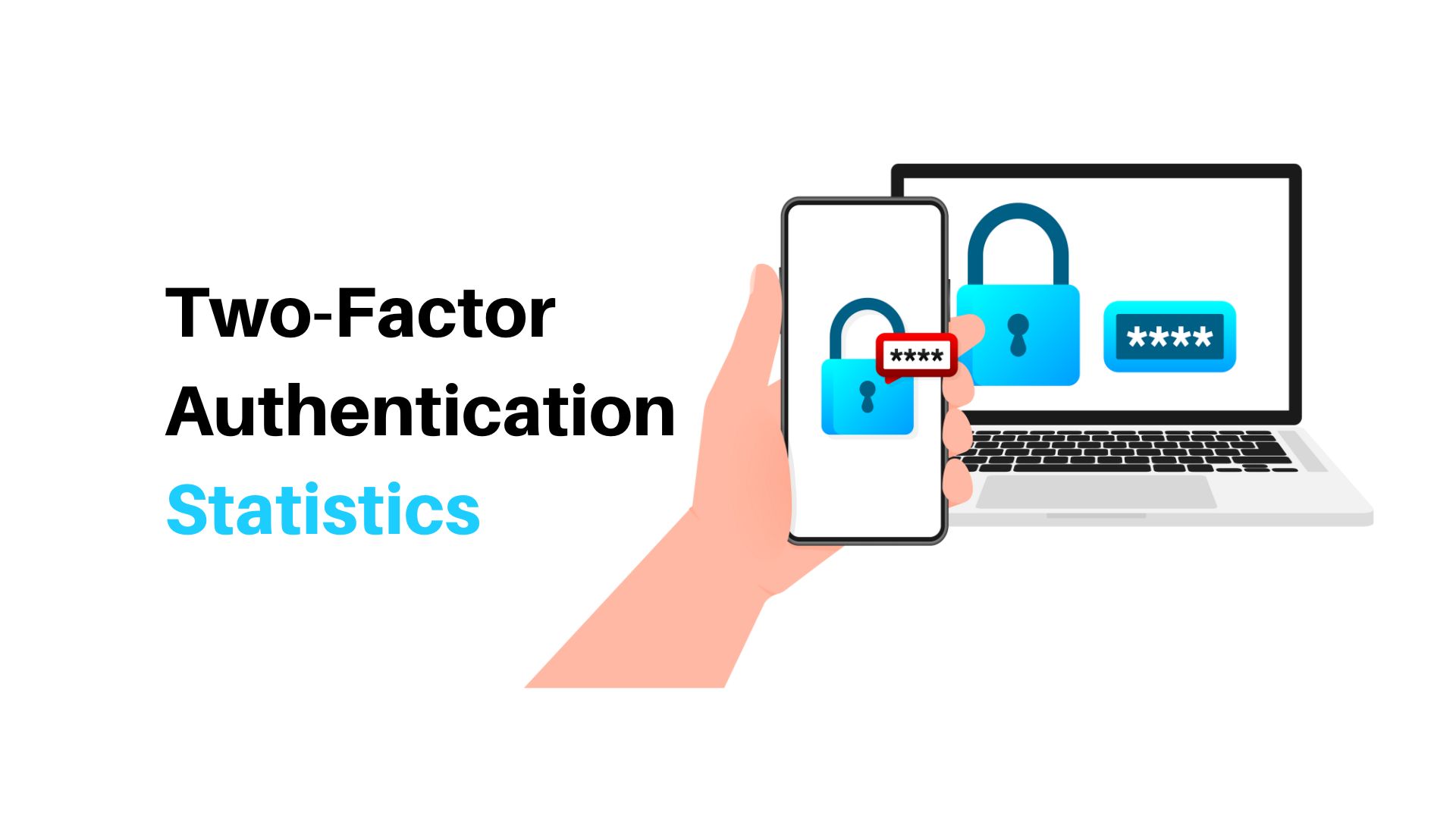
Page Contents
- Introduction
- Editor’s Choice
- What Is The Significance Of Two-Factor Authentication?
- Important Two-Factor Authentication
- How Many People Use 2FA?
- Two-Factor Authentication Statistics from Industry
- Is Two-Factor Authentication Really Worth It?
- Types of 2FA Implementation
- The Benefits of Two-Factor Authentication
- Levels for 2FA
- The Impact of Covid-19 on Two-factor Authentication Market
- Conclusion
Introduction
Two-Factor Authentication Statistics: Cyberattacks have become more commonplace in recent times. It is the reason why stronger passwords are essential to secure our data online. However, even using passwords they are vulnerable to being hacked. In this article, we will learn the Two-Factor authentication statistics.
This is the reason two-factor authentication is here to help since it adds another level of protection that protects your information. A two-factor authentication application helps you protect yourself by making it impossible for hackers to gain access to your accounts online.
If you'd like to keep your accounts online and data being compromised check the most recent two-factor authentication information and discover how to safeguard your accounts more effectively.
Two-factor authentication (2FA) is an additional security measure that provides an additional layer of security for online accounts. Users must submit two documents to prove their identity before being able to use their accounts. This additional measure of protection is getting more popular as companies and individuals are opting for 2FA to safeguard their data.
Editor’s Choice
- The global passwordless authentication market was estimated in 2022 at $15.6 billion.
- 80% of all companies around the world in 2022 utilized passwords as their main security element.
- In April 2023, around 158 businesses worldwide used Google Authenticator as an authentication tool that requires two factors.
- In April 2023, RSA SecurlD dominated the two-factor authentication software market, with an impressive 42.89% of the market.
- The tech industry of 2023 has 743 customers that use 2-factor authentication technologies.
What Is The Significance Of Two-Factor Authentication?
Two-factor authentication (2FA) is an authentication technique that requires users are not allowed access to their account until they enter their password, and also provide different evidence of identity (for instance, they may have to verify their fingerprint or prove that they possess the security token). Because passwords are frequently stolen and therefore not enough to protect accounts using two-step authentication reduces the possibility of unauthorized access to account accounts and allows organizations to more effectively protect themselves against cyberattacks which are the result of the use of phishing or human error.
Important Two-Factor Authentication
- Two-factor authentication was mandated in 150 million Google users in 2021.
In 2021, at the time of its end, Google auto-enrolled 150 million users in two-factor authentication for accessing their accounts. According to 9to5 Google, the move resulted in a 50% decrease in the number of compromised accounts. This is a huge accomplishment that is a testament to the positive effect 2FA can bring to an authentication process as opposed to using an old-fashioned login with a username and password.
- The technology industry is the leading sector in implementing multifactor authentication.
The year 2021 was the most successful for MFA. LastPass is that firms operating in the technology and software sector were the most active in adopting MFA with nearly 39% saying they already used MFA. Education was next by 33%. However, most alarmingly, the sectors which handle the most sensitive data of customers like insurance and legal were the least likely to use MFA, and 20% of employees employing this method of authentication.
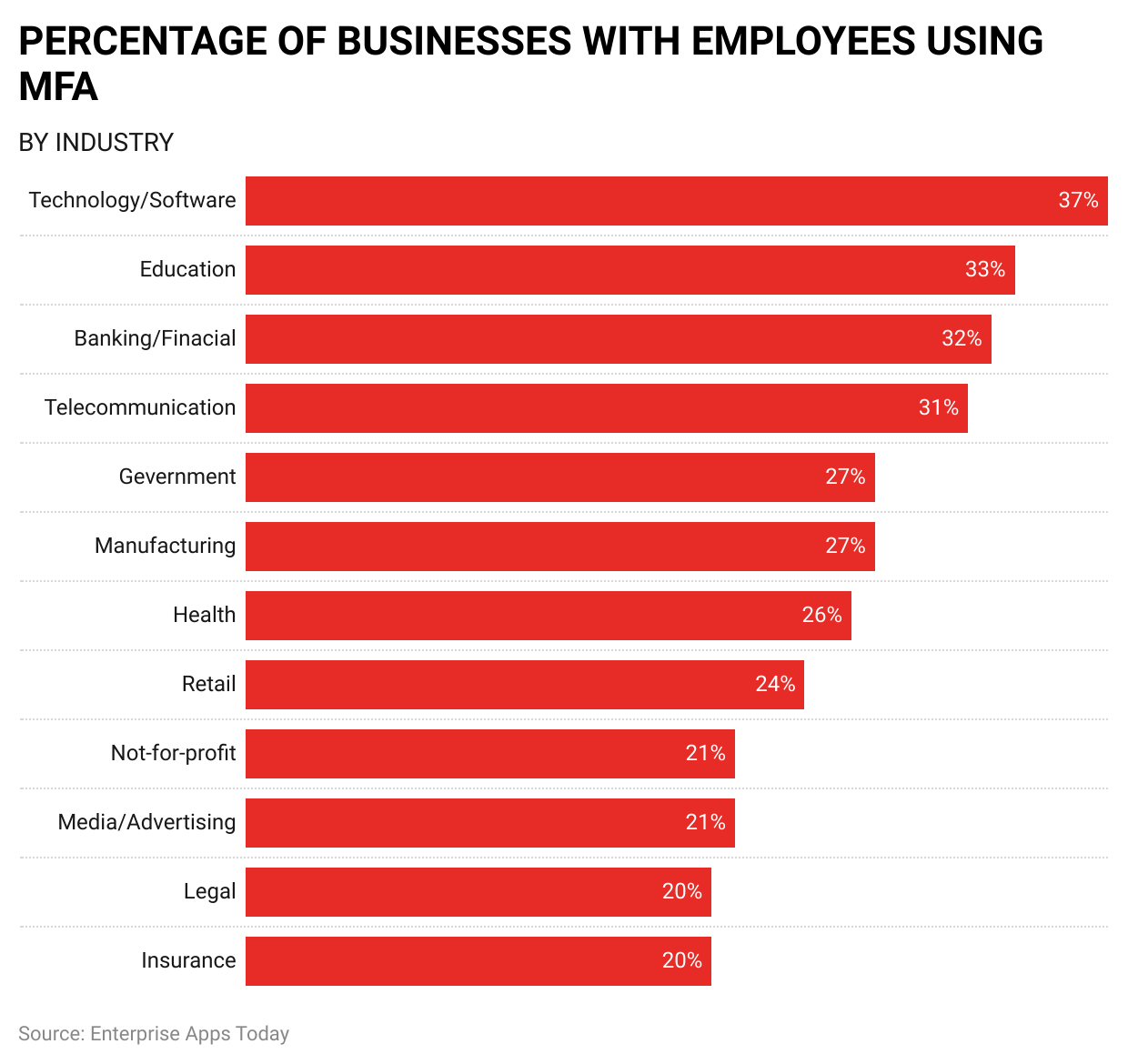
(Reference: comparitech.com)
- 61% of people use the same password for several accounts.
A password manager can make life much easier for those who struggle to remember passwords. To prevent your account from being compromised, it's recommended to have an alternate password for each account you are using. If hackers guess one password, there's a good chance they'll be able to make use of the exact login details to sign into your account on other websites. Unfortunately, LastPass reports that more than half of us reuse the same password on multiple accounts.
- Employed users have 2FA in greater quantity than those who are unemployed.

(Reference: comparitech.com)
Duo Labs' report revealed an interesting result: those employed (79% of users) are adamant about the security of 2FA as do 60% of users who are unemployed.
- Two-factor authentication was made obligatory for 150 million Google users by 2021.
At the end of 2021, Google auto-enrolled 150 million users to use two-factor authentication for accessing their accounts. According to 9to5 Google, the switch resulted in a 50% decrease in the number of compromised accounts. This is a huge accomplishment that is a testament to the positive effect 2FA can have on the authentication process as opposed to using the traditional account username or password for authenticating.
- The technology industry is the leading sector to adopt multifactor authentication.
in 2021 LastPass found the firms operating in the software and technology sector were the most proactive in adopting MFA and three-quarters of the respondents reported they already used MFA. Education followed closely with 33%. But, more alarmingly the sectors that handle the most sensitive customer information such as insurance and legal did not have a large use of MFA, and only 20% of employees employed MFA as an authentication technique.
- USD 18.8 billion was devoted to expenses for recovery through the American government in 2020.
American City and County reported the average effects of downtime as well as recovering from an attack. Internal and external threats to accounts of government employees are mitigated by 2FA to minimize the chance of phishing attacks as well as hacking of accounts.
- Two-factor authentication on Twitter is astonishing
In the 2021 report on transparency from Twitter that was released in 2021, Twitter revealed that its two-factor authentication adoption rate is shockingly low. In the period of reporting between July and December 2020, only 2.5% of users opted for 2FA, an increase of 8.7%.
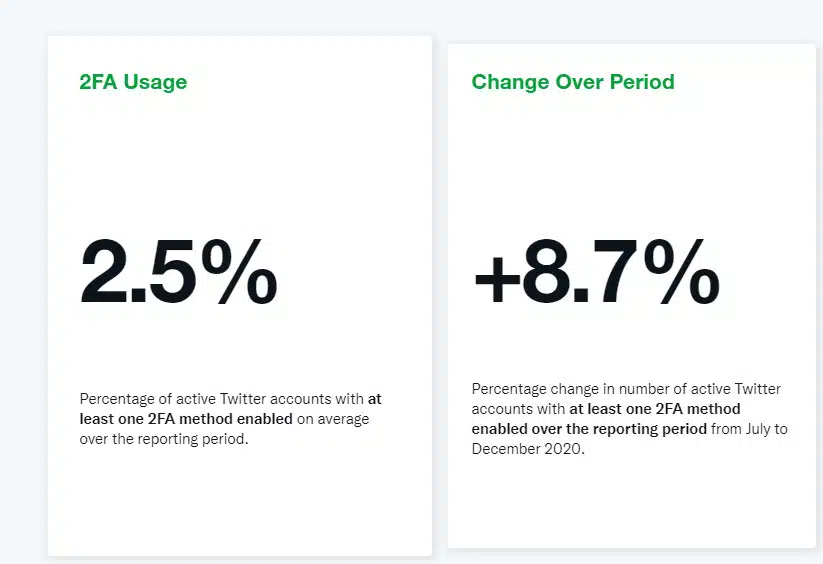
(Reference: comparitech.com)
- Microsoft Authenticator records 75 million installations
According to a recent report by Redmondmag, Microsoft Authenticator has experienced a rise in active users since it introduced the option of creating passwords. The application, which is available on iOS and Android is now boasting an active user base of more than 75 million.
- Accounts with high risk are subject to 2FA requirements.
Facebook announced on December 20, 2021, that accounts with high risk like human rights activists and officials of government will need to use two-factor authentication. According to TechCrunch, Facebook 2FA is now available on more than 1.5 million accounts.
- Most often, software-based authenticators are used by companies
95% of companies that used 2FA by 2021 used applications that were based on software, like the mobile application. This could be due to the low-cost benefits of software-based authentication. Only 1% of respondents employed hardware-based authentication such as the use of a physical token, and 4% of employees reported that they used biometrics like fingerprints or facial recognition, LastPass says.
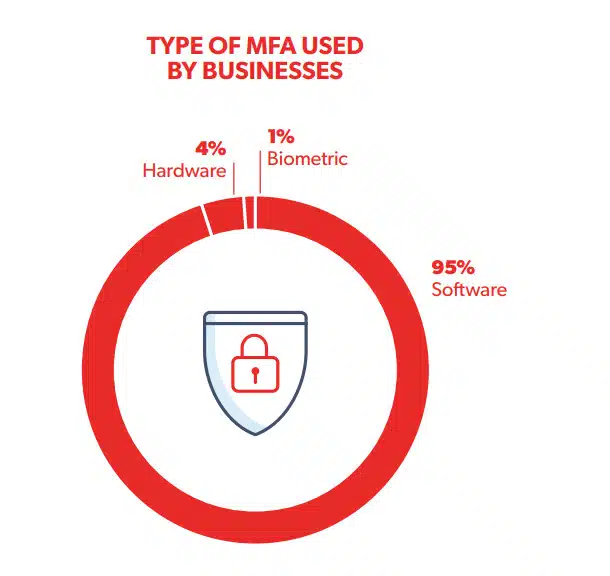
(Reference: comparitech.com)
- A report released in 2019 by Microsoft discovered that 2FA blocks 99.9% of automated attacks.
For security in the workplace, 2FA is a common requirement for nearly every company and allows employees to be protected against cyberattacks. 2FA offers users at least two forms of identity, which allow users to use the service through a new account.
- 42% of businesses in 2021 mentioned costs as a reason for not deciding to use multi-factor authentication.
In contrast, 48% of respondents felt it was a challenge to integrate into current systems, 26% felt it needed too many resources to manage and deploy 49% also cited the poor user experience.
- 56.7% of businesses in 2021 utilized an authentication application in the event of a security breach.
In contrast the other way around, only 6.7% of businesses using the secondary MFA email type suffered the risk of a security breach.
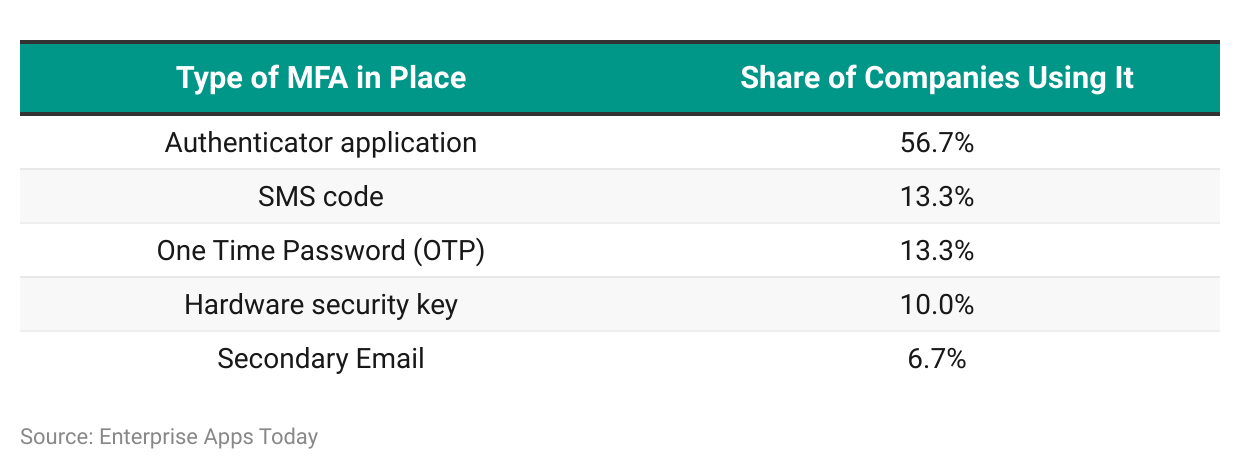
(Reference: vpnalert.com)
How Many People Use 2FA?
Two-factor authentication Statistics (2FA) is quickly becoming a widely used measure to protect our online accounts and digital documents. In 2019, there were roughly 10.7 billion 2FA-enabled accounts, and this number is projected to grow to ~15 billion in 2021. With this growing popularity, let’s take a closer look at the statistics associated with 2FA usage.
According to a survey conducted by Google, approximately 45% of internet users have enabled 2FA on at least one of their accounts. This is an impressive increase from 33% back in 2017. Breaking the number down further, 55% of tech-savvy users have enabled 2FA on their accounts. Among the age groups, the highest percentage of 2FA usage is seen among the 25-35 age category at 48%.
- 10.7 billion 2FA-enabled accounts projected in 2021
- 45% of internet users have enabled 2FA on at least one of their accounts
- 55% of tech-savvy users have enabled 2FA on their accounts
- Highest 2FA usage seen among age 25-35 age category at 48%
Two-Factor Authentication Statistics from Industry
In today's world of digital connectivity protecting the security of sensitive data and digital assets is crucial. 2FA or Two Factor Authentication (2FA) is now an extremely effective method to improve security on the internet. It provides another layer of security over traditional passwords, greatly decreasing the chance of access being unauthorized.
- in April of 2023, RSA SecurID holds a leading position in the market for two-factor authentication software with an impressive 42.89% market share.9
- Near, Clef and Symantec VIP take the second and third places with market shares of 16.46% and 7.34%, respectively.9
- By April 20, 47.13% of businesses that use two-factor authentication software reside within the United States, making it the top adopter.9
- The United Kingdom and the Netherlands come in second and third spots with adoption rates of 13.54% and 11.20%, respectively.9
- in 2023, the tech industry has 743 customers who have implemented two-factor authentication.
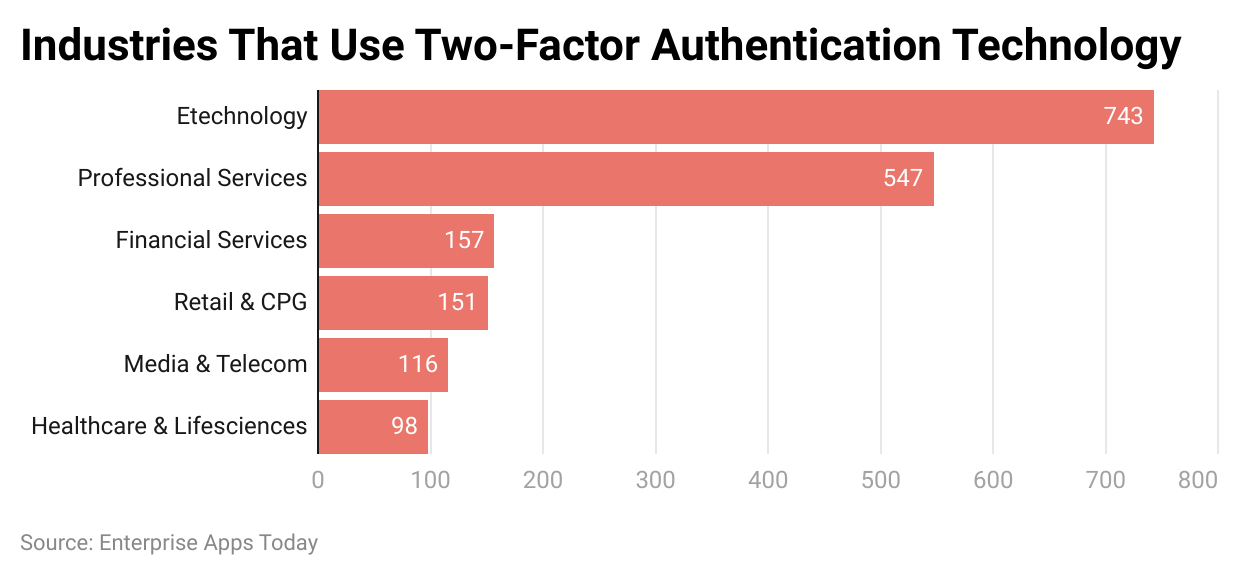
(Reference: marketsplash.com)
- The financial and professional services industries are close behind with 547 and just the number of customers each within this similar year.9
- in 2023 companies that have 9 or fewer employees have the most use for two-factor security tools.9
- Globally 885 businesses with less than nine employees use 2FA tools, while companies that have between 20 and 49 employees' numbers are 511 for comparison.9
- The Cyber Security Breaches Study by the DCMS from 2022 shows that only one in three organizations has an obligation for 2-factor authentication.6
- For retailers, Two-Factor Authentication (2FA) is an excellent tool for verifying the identity of users who access their networks from remote desktops or mobile devices.2
- In the educational sector, 33% of workers have the greatest usage percentage of the 2FA.
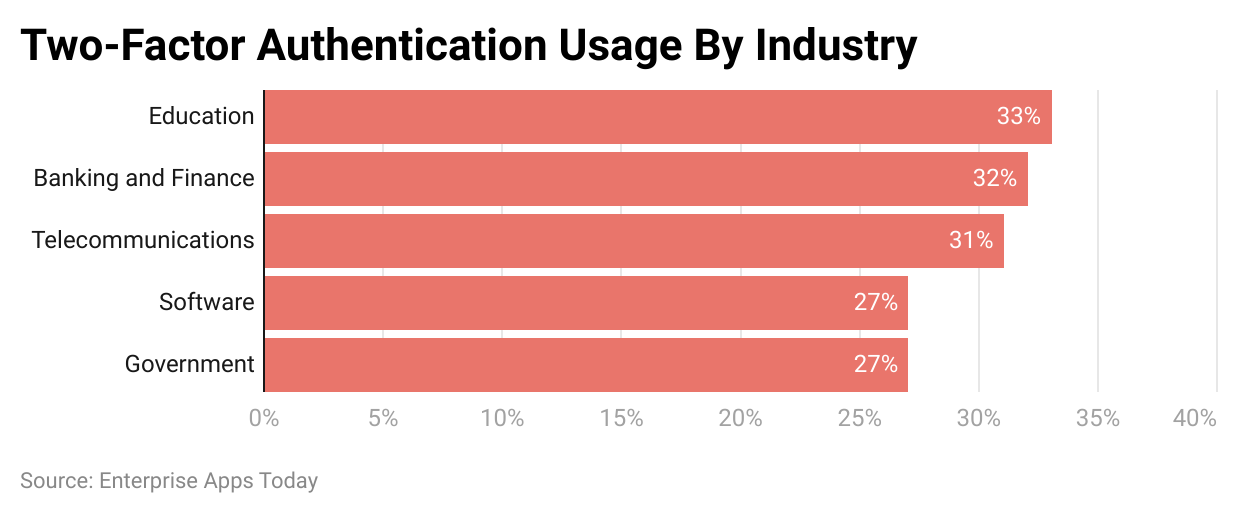
(Reference: marketsplash.com)
- In a variety of industries Hardware tokens are the only ones used by the financial sector even though they have a low 4.4% acceptance rate.2
- In the case of cyber-attacks institutions are also more prone as they have a risk 300 times higher when compared to the other industries.5
- 38 A majority of respondents from the financial sector believe that technological advances have increased the risk that comes with information security security.5
- The two companies Microsoft as well as Google 2FA offer 100% security for attacks that are automated. attacks.4
- MFA is currently an essential security measure for 57% of the largest organizations.4
- For large corporations, 87% of all 10,000 employees are required to utilize MFA. However, for smaller to medium-sized companies only 13% or less of employees must utilize MFA.
Is Two-Factor Authentication Really Worth It?
Security Is Paramount
The digital age is irreversible, with an ever-increasing dependence on services online. With such an interconnected set of systems, security is of paramount importance. Two-factor authentication, or 2FA, is an increasingly popular form of security providing an additional layer of protection to sensitive data.
The Numbers Don’t Lie
2FA is worth it, as the numbers suggest. Research has shown that the use of 2FA has reduced account takeovers by 99%:
- Passwords stolen by hacking are rendered useless with 2FA in place
- Malware and viruses can no longer impact the security of accounts using 2FA
- Accounts set with 2FA are at a dramatically reduced risk of takeover
Other studies have suggested that the use of 2FA has led to an increase in customer loyalty for businesses, suggesting that the costs associated with 2FA are balanced out by the additional security it provides and the increased customer loyalty that comes as a result.
Types of 2FA Implementation
-
Employee-facing 2FA
This is 2FA at an internal, corporate level and is typically applied to email, VPN, remote access, and third-party services such as file-sharing apps, cloud repositories, etc. Companies must ensure that this implementation is uniform throughout all levels of the organization.
-
Customer-facing 2FA
This is a layered authentication process that consumers of an organization’s products, applications, or services must go through for extra security. We typically come across customer-facing 2FA with banking solutions. This is usually implemented to honor SLAs and maintain regulatory compliance.
Two-factor authentication Statistics isn’t just a matter of security. Depending on the industry that the organization functions in, it may be a regulatory mandate as well. Some industries that commonly employ 2FA are healthcare (which has stringent HIPAA regulations to deal with), e-commerce, social media, and education (considering that the COVID-19 pandemic has pushed most education online across the world).
The Benefits of Two-Factor Authentication

(Source: spiceworks.com)
Levels for 2FA
The level at which the device is the point at which 2FA is used to verify that the user is logged into the device or the system. For instance, asking for the password and code of the device to sign into the computer.
Level of application: It is where 2FA is introduced at the application level. For instance, using fingerprints and a password to log in to the payment app.
Level of Functionality: It is the time when 2FA is introduced just before the specific action that users can take within the application. For instance, it is possible to send OTP to the mobile of OTP to the mobile of the user after a logged-in user attempts to change their bank account password on their mobile.
The Impact of Covid-19 on Two-factor Authentication Market
After COVID-19 the dimension of the multi-factor authentication market is estimated at $10,300 million by 2020. The market is forecast to increase to $40,000 million in 2030.
There has been a dramatic increase in cyber-related attacks, during the outbreak, the need for a multi-factor authentication system has increased, resulting in an increased profit margin. According to a study released by security solutions company F5 Labs, a 220% increase in the frequency of phishing-related attacks was recorded from the time the first phase of lockdowns was initiated in several countries.
This led to more companies to improve their security system. Additionally, as the rise of working from home and remote working became increasingly popular, the world saw an increase in cyber-criminal activity that targeted numerous organizations as well as their clients. In the end, the demand for greater security of important corporate assets grew and the market for multi-factor authentication grew in the aftermath of the pandemic.
Conclusion
In conclusion, two-factor authentication is becoming increasingly popular as a security measure for businesses, organizations, and individuals. The statistics show that two-factor authentication is an effective way to protect data and accounts from unauthorized access.
It is important to remember that two-factor authentication is only one part of a comprehensive security strategy. Other measures such as strong passwords and regular security updates should also be implemented to ensure the highest level of security.
Sources
FAQ.
MFA and 2FA can present some challenges, such as user resistance, security gaps, and integration issues. To overcome user resistance, you should educate your users about the benefits and risks of MFA and 2FA and make the authentication process as seamless and user-friendly as possible.
Two-factor authentication (2FA) is a security system that requires two separate, distinct forms of identification in order to access something. The first factor is a password and the second commonly includes a text with a code sent to your smartphone, or biometrics using your fingerprint, face, or retina.
2FA is essential to web security because it immediately neutralizes the risks associated with compromised passwords. If a password is hacked, guessed, or even phished, that's no longer enough to give an intruder access: without approval at the second factor, a password alone is useless.
So, two-factor authentication (2FA) requires users to present two types of authentications, while MFA requires users to present at least two, if not more types of authentications. This means that all 2FA is an MFA, but not all MFA is a 2FA.
Multi-factor authentication (MFA; two-factor authentication, or 2FA, along with similar terms) is an electronic authentication method in which a user is granted access to a website or application only after successfully presenting two or more pieces of evidence (or factors) to an authentication mechanism.
SMS Token. Perhaps the most common method of implementing 2FA. This method sends the user a unique token via SMS text message, normally a 5–10-digit code, after they have successfully entered their username and password. The user then needs to provide this unique token before they are granted access

Barry is a lover of everything technology. Figuring out how the software works and creating content to shed more light on the value it offers users is his favorite pastime. When not evaluating apps or programs, he's busy trying out new healthy recipes, doing yoga, meditating, or taking nature walks with his little one.